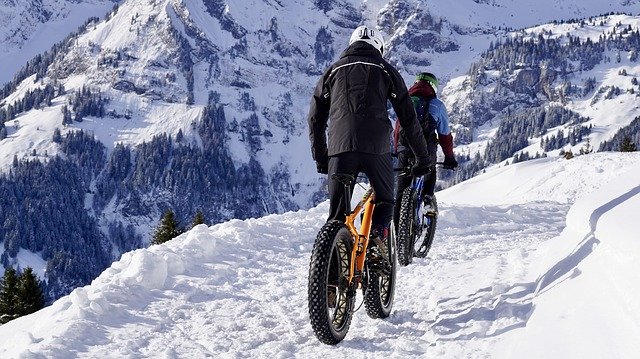
Staying warm while riding during winter is no easy feat. You have to think creatively, get the right gear and spend time warming up. However challenging it may seem— staying warm during winter rides is far from impossible. In fact, winter mountain biking can be some of the most fun! Here are seven ways to stay warm in the saddle when biking during cold weather.
Layer Up
You need three basic layers for cold weather riding— base layer, insulating layer and outer layer. The base layer will wick sweat away from your skin, while the insulating layer keeps you warm. The outer layer should be a shell that is windproof and waterproof. These three layers work together to keep you warm and dry while riding in cold, rain and snow.
Head Sweat
Wear a skull cap or headband under your helmet to help keep your head warm without overheating. A lot of blood circulates through your head, so keeping it warm will also help keep the rest of your body warm.
Warm Up
Before you get in the saddle do 10-15 minutes of warm up exercises to help generate some body heat. Jumping jacks, push ups, burpees, jogging in place and crunches can help get your heart pumping so you and your muscles are nice and warm before you start to ride.
Winter Gloves
Your hands will be exposed to some pretty gritty elements, so thick, wicking winter gloves are key to a comfortable cold weather ride. Don’t go with something so thick you can’t hold on to the handle bars; windproof backs usually help protect your static hands from the harsh elements.
Waterproof Socks and Shoes
You’ll appreciate the extra you’ve spent on socks and shoes that fight off wetness when riding through slush and snow. Some mountain bikers wear hiking boots in the winter. They are clunkier, but often provide the heat and wetness protection you need.
Ride When Sunny
Take the bike out during the warmest, sunniest time of the day. That may mean switching your early morning rides to afternoon rides. Take advantage of the sun’s warmth when it is directly overhead or higher in the sky.
Work First
Make the hardest part of your ride— the climb— the first part of your ride. You’ll generate tons of warmth starting off with an uphill climb. By burning calories you’ll build up body heat that can sustain you for the entire duration of the rest of your ride.
Winter Tires
Avoid slipping and falling on snow and ice by installing winter specific tires on your mountain bike. Look for tread with deeper spikes to grip better in the snow and tires with small metal spikes— like cleats— for ice rides.
Stop and Adjust
As you start to heat up you may start to get uncomfortable. Don’t hesitate to stop riding, pull over and adjust your clothing. Take off only one layer at a time so you don’t switch too quickly from warm to cold.
Good Lighting
Winter days get darker earlier so it’s important you take a good light out with you. Many mountain bikers use a headlamp, headlight and tail light. Find the brightest lights you can so they can cut through and illuminate your path when the winter skies are overcast and grey.
Winter riding takes a little additional preparation, but the good news is you have a variety of options when it comes to your cold weather gear and winterizing your bike. Keep yourself and your bike riding smoothly by exploring these cold weather mountain biking tips.